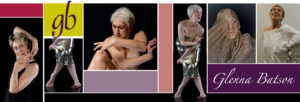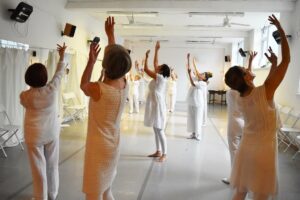Arts Sci ArtScience Hub
Artscience
Dance, Neuroscience & the Somatic Arts
Glenna Batson – artist statement
Dancing while Aging – credo & blog
Teaching Philosoph
I consider myself a movement muse – one who inspires people to find their impulse to create through movement – functional or artistic – for health and healing.
I work as a movement mentor and community dancer, teaching adults – independently aging with or without neurodiversity. I currently live in an elderly community in Maryland and reach out locally and internationally to collaborate with others engaged in the dance arts and arts for health.
I love to create classes designed to appeal to adults on the aging continuum who have little to no exposure to dance or other formal movement training. These have included in the recent past:
Living Traditions – Sacred Moves
Moving ‘Right’ along
FUN-damentals of daily living
Body and Mind in Motion
Rhythm Without the Blues
Movement, Motif and Meaning
Alexander Technique in Motion
Movement Improvement Everyday… the Alexander Technique Way
Moving for Living, Moving for Life
A.T. Ease, moving well with arthritis
Stretch without Strain/Lengthen & Strengthen
Dance for Parkinson’s
I am still engaging in projects involving dance for people living with Parkinson’s. As a research associate and fellow traveller, I am proud to be contributing to the work of dance artists Murielle Elizéon & Tommy Noonan of Culture Mill, their performance lab in Saxapahaw, NC. This duo introduces the art of dance in ways that bring deeply emotional expression and resonance to all participants as they explore new realms of physicality for those living with challenges.
Check out the interview with Glenna. Learn more about the fabulous work of these award-winning artists on their website.
how I introduced dance for Parkinson’s to folks in North Carolina (2009-2014)
In the early 1980’s, when I was learning to become a physical therapist, the philosophy was that exercise of any kind was contraindicated for people living with Parkinson’s disease. Today, such a concept is discredited. Researchers have shown that many forms of exercise stimulate the brain to form new pathways for movement. Exercise helps people with Parkinson’s live longer and stronger. Dance for Parkinson’s is one of the more powerful exercise choices – and so many types of dance! Ballet, modern, folk, Tango, improvisation – virtually any rhythmic option offers physical, psychological and social benefits! Today, Dance for Parkinson’s is a world-wide movement phenomenon, with teachers training in over sixty countries as well as an extensive online program.
Between 2008 and 2016, I was passionate about designing pioneering research on the effects of improvisational dance on balance for people living with Parkinson’s.
I couldn’t have done this research without the help of my colleagues from the Translational Science Center at Wake Forest University Baptist Medical Center – chiefly – dance professor Christina Soriano, and neuroscientist Dr. Christina E. Hugenschmidt. My research was based on the hypothesis that this population could move without the assistance of mimicking, copying, mirrors or even rhythmic music. Improvisation was a way to help them move spontaneously and well. Christina Soriano created her own improvisational movement structure for several pilot clinical studies,.The research was a first of its kind in North Carolina, a welcomed addition to the Dance for Parkinson’s literature, and a springboard for further studies and local classes. Sample publications
The video Coming Together – Dancing with Parkinson’s, from one of our first studies, garnered honorable mention at the Third International Parkinson’s World Congress (producer, Nicholas Hristov and team of the Center for Design Innovation, Winst0n-Salem). We were nominated for a Special Topics award in Frontiers for our methods article published in 2016 in Frontiers in Neurologyy,
The two Christina’s have gone on to win two NIH awards for researching the effects of dance for people with early cognitive declines. Soriano also initiated a deeper investigation into improvisation. Check out her entries on IIMROVment.MP
The Somatic Arts: Embodiment for the 21st Century
What is Somatics? a starting point for teaching.
Throughout much of the 20th century, somatic education (Somatics) was a powerful force that slowly changed the face of dance training. The change took time — approximately seven decades — for Somatics to shift from merely being a curricular ‘adjunct’ of dance conditioning, to emerging sui generis as a powerful medium for training reflective and autonomous dancers. A non-corrective approach to learning skills of technique and performance, Somatics spawned several generations of process-based movement praxis in learning the many dimensions of embodiment. With the 21st century well underway, Somatics has re-surfaced as an intelligent movement-centered response to complex problems within the larger sphere of bio-politics. The founding principles and processes are evolving, aligning with potentially transforming processes for the individual dancer and promoting societal wellbeing. Somatic experts and somatically-informed dance activists, are re-negotiating issues of control – of ourselves and of our environment. What lessons can we learn from the living history of Somatics that challenge compartmentalized, reductionistic methods of teaching and learning? How can emergent somatic pedagogies help foster autonomy? The course will engage students in mining the hallmarks of embodied somatic praxis. Classes will draw from the history of Somatics and its scientific and psychosocial underpinnings of the critique around current societal issues. By reframing Somatics as emancipatory and ethical dance education, students will actively address the over-arching questions: How should we dance? How should we live?
Embodiment and Brain Health
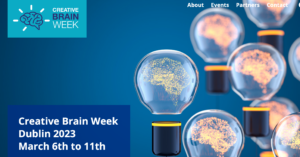
In 2022, I presented with Irish dance artist Ailish Claffey at the Global Brain Health Institute conference, Creative Brain Week 2022, https://creativebrainweek.com Neuroscience Meets Creativity in Action. This session introduced our collaborative intensive dance project Meet & Move, dance for all.
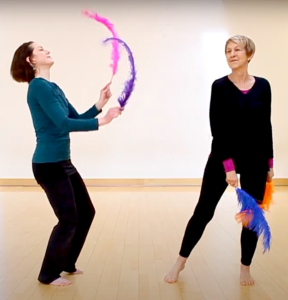
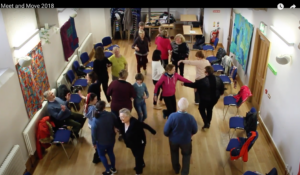
photos, Cathy Coughlan
These days I am affiliated with the Global Brain Health Institute at Trinity College Dublin. One of the trends in curricular development among the Atlantic Fellows of the Institute centers on the value of embodiment through arts training/practice for maintaining brain health throughout the life span. Stay tuned for reports on future events in 2023.
Community Dance
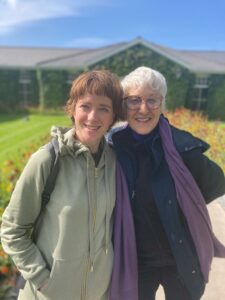
Since 2016, I have worked intermittently in Ireland, teaching movement education at various arts and aging centres (e.g., the McCauley Place, Naas, Co. Kildare), Dance House (Dance Ireland, Dublin), and at the University of Limerick Dance Department. I participated in dance in health initiatives, sponsored and funded by the Kildare County Council. All these events focused on crafting connections, building community and sustaining dance and health practice. From 2017 to the present, I collaborated with Irish independent dance artist, Ailish Claffey, in Meet & Move | Dance Unlimited – community dance project for adults of all ages and challenges. Our latest collaboration (October 2023) was, The Incubator, a week-long intensive workshop that brought together women across a spectrum of ages and training. These workshops were funded by the Kildare County Council.
Between 2017-2019, I performed with independent community dance artist Philippa Donnellan and her work at Broadreach, dance for ages 50+ at the at CoisCéim Dance Theatre (Dublin). A hallmark was an evening performance, The Emily Project, co-directed by Philippa and theatre director Noelle Brown.
The experience led me to create graphic artwork – folded packing paper paired with my photos of ice sickles – giving a sense of Emily Dickinson’s corseted, yet deeply sensitive and artistic world.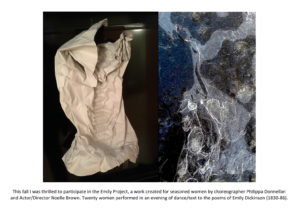
Emily | 2017 http://coisceim.com/emily/
This is my letter to the world,
That never wrote to me,–
The simple news that Nature told,
With tender majesty.
Her message is committed
To hands I cannot see;
For love of her, sweet countrymen,
Judge tenderly of me! …..Emily Dickinson.
